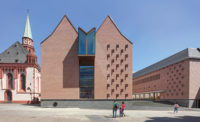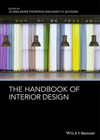Chemnitz, Germany
Erich Mendelsohn's Schocken Department Store in Chemnitz, completed in 1930, is well known to architects worldwide. Yet encountering the recently renovated early-20th-century landmark will be a revelation, even for those familiar with it. The restored curved facade, with its ribbon windows and limestone spandrels, seems to float above the fully glazed ground floor, forming an arresting backdrop to a busy intersection in this central German city.
For their recent conversion of the structure, which had operated continuously as a department store until 2001, and had been designated as a state historic monument 20 years earlier, designers developed a twofold strategy: reconstruct Mendelsohn's facade and respectfully reinterpret the interior. They needed to accomplish these goals while contending with constraints such as the building's low floor-to-ceiling heights (the levels above the ground floor are only 10 feet tall) and problems like condensation, stemming from the original facade's early curtain-wall technology.
Working from original documents and details discovered on-site, the project team rebuilt Mendelsohn's exterior. “In many places they had to save money,” notes Thomas Knerer, partner of Knerer und Lang. “We tried to re-create that.” For example, Schocken had rejected steel windows due to the expense, opting for wood instead. So, for the restoration, the architects chose operable wooden frames painted white on the interior and light brown on the outside. They replaced the dark stone with limestone from the original Bavarian quarry. And on the facade's inside face they preserved important details like polished limestone ledges that step down from the windows. But in order to enhance the assembly's performance, the designers relied on current construction practices, including double-glazing and improved insulation.
They took more license inside to accommodate SMAC's program. Here they altered the typical floor layout, which originally featured services and vertical circulation clustered at the rear, with most of the roughly triangular floor plate left open for the display of merchandise. The new configuration has support spaces lined up along opposite sides, with a quarter-pie-shaped zone in between devoted to exhibitions.
The architects have made the most of a key feature of the original department store's interior—its 20-by-20-foot grid of reinforced-concrete columns and beams. They have left these structural elements exposed, refinished them, and painted them white. Although a suspended ceiling was necessary to hide conduit, cabling, and other services, its modest depth (about 15 inches) ensures that the beams remain visible.
Some interventions help establish spatial and thematic connections between the museum's various levels. For example, an interactive model of Saxony is visible from all four stories of the new atrium extending upward from the lobby. The rear of the museum includes a multilevel “stair-ramp” made up of shallow risers and elongated, inclined treads. Enclosed by backlit polycarbonate and enlivened with environmental sounds, the new circulation element creates an engaging transition for visitors as they ascend, advancing from exhibits devoted to the Ice Age on the second floor to those that discuss the region's more recent history on the third and fourth. The fifth floor provides space for special exhibitions, and the uppermost public level—the sixth—contains an event space and museum offices.
Custom-designed luminaires that incorporate both LED strips and flexible spots illuminate the galleries. The pendants, made of stainless steel, are fixed at one end but can be rotated 90 degrees to accommodate display changes.
In order to further control the museum environment and shield the exhibitions from sunlight entering through the ribbon windows, the project team created what it refers to as the “museum wall,” a full-height, 7-foot-thick curving partition placed parallel to the facade on each of the gallery levels. On the side that faces the main exhibition area, the wall incorporates panoramas and display shelving, articulating its surface. On the other side, the one facing the restored facade, the wall allows for narrow, daylight-filled galleries, and offers space for installations dedicated to Mendelsohn's architecture, the Schocken department store chain, and the visionary client, Salman Schocken. Here one can ponder this monument's complex legacy or simply gaze at the city. Offering one of the most satisfying experiences in the building, these galleries present the project's contrasting themes—preservation and reconstruction, reuse and invention—creating an enriching, yet provocative, museum encounter.
Although the project takes liberties with the original, the renovation gives an important city landmark a new lease on life while gracefully bridging the past and the future. As Uwe Brückner, a partner at Atelier Brückner, observes, Mendelsohn's building is “no longer a place where material culture is sold.” Instead, it has been transformed into one “where it is presented and reflected upon.”
People
Client:
Owner:
Architects: And
Knerer und Lang
Personnel in architect's firm who should receive special credit:
Interior designer:
Engineers:
Fire protection:
Building services:
Electrical:
Thermal building physics:
Consultant(s):
Lighting:
Acoustical:
Photographer(s): Size: 183,000 square feet Construction cost: $36 million Completion date: May 2014 |
Products
Structural system
Exterior cladding
Other cladding unique to this project:
Windows
Doors
Metal doors:
Wood doors:
Fire-control doors, security grilles:
Upswinging doors, other:
Hardware
Interior finishes Conference rooms, 5th to 7th floor: Suspended ceilings with hole matrix
Cabinetwork and custom woodwork:
Solid surfacing:
Floor and wall tile:
Wall tiles WC museum:
Wall tiles WC bureaus:
Carpet:
Raised flooring:
Furnishings
Lighting
Main staircases:
Conveyance
Plumbing
Tubular radiators (situated in the two main staircases): Zehnder excelsior — |















